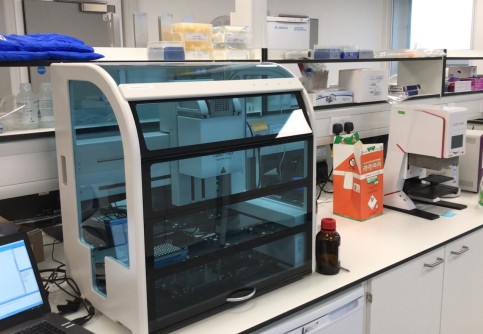Robotic testing platform helps to scale up COVID-19 testing capacity
by Ryan O'Hare

An Imperial team has repurposed robotic technology normally used for synthetic biology research to help with testing for COVID-19.
During the early stages of the coronavirus pandemic, the rapid rise in the need for testing led to bottlenecks during peak demand, creating a need for new approaches to boost testing capacity.
We recognised early on that we needed to work shoulder to shoulder with our colleagues in the NHS to ensure we could get them something that was workable in their labs. Professor Paul Freemont Imperial College London
Researchers at Imperial were able to repurpose an existing high-throughput robotic platform as a way to help NHS diagnostic labs avoid these bottlenecks – cutting their reliance on reagents in high demand from other testing platforms around the country, which were in very limited supply.
The team has now made full details of their work available today in a paper in the journal Nature Communications so that the technology can be adapted more widely for testing purposes.
According to the team, the study is the first to show how Biofoundries – which use the robotic platforms in synthetic biology research - could help health services around the world to rapidly respond to emerging infectious disease threats in future.
In addition to helping with COVID-19 testing, they hope this will enable the development of low cost testing platforms for infectious diseases such as HIV, Hepatitis and Influenza.
Boosting capacity
The platforms, normally based at the London Biofoundry on Imperial’s White City campus, are usually applied in a range of cutting-edge research projects, including researching the cause of infections in vulnerable people, such as those living with dementia.
Each machine has the capacity to process up to 1000 samples within 12 hours. But with initial funding from the UK Dementia Research Institute, a team led by Professor Paul Freemont was able to adapt the platform to help with testing for active cases of infection with SARS-CoV-2, the virus that causes COVID-19.
This workflow will serve as a blueprint for others to implement in the UK and abroad in low- and middle-income countries Dr Michael Crone Imperial College London
The technology is now in use in NHS pathology labs for frontline testing, where the system helped the diagnostic team to test 5,000 samples in just five days after a local COVID-19 outbreak.
Professor Freemont said: “We were working against the clock and forced to think about our technology in a whole new way. We recognised early on that we needed to work shoulder to shoulder with our colleagues in the NHS to ensure we could get them something that was workable in their labs.
“We needed to be able to deploy it quickly and scale it up to meet demand. It was a huge challenge, but we were all totally committed to making it work, even when that meant persevering through numerous blocks and challenges along the way.
Adapting existing platforms
In order to repurpose the robotic platform, the Imperial team had to create new software and hardware, as well as developing new testing standards to guarantee highly reproducible results. Building on the existing antigen testing platforms in clinical use, they applied two new detection methods; based on the gene editing protein CRISPR, and a robust colour change assay called LAMP.
Working with clinical colleagues based at the Imperial College NHS Healthcare Trust, they were then able to validate their platform on patient samples to show how the platform compared.

According to the team, their platform will help to overcome bottlenecks as it could be recalibrated to use reagents from a number of manufacturers – overcoming issues linked to the supply chain.
Dr Michael Crone, from the Department of Infectious Disease, said: “Notably, in comparison to other workflows, the setup requires fewer trained staff to run. Together with our North West London Pathology colleagues we have therefore developed and validated a truly robust, scalable, automated diagnostic testing platform. This workflow will serve as a blueprint for others to implement in the UK and abroad in low- and middle-income countries.”
Automation manager Dr Marko Storch added: “It was important to us to share our insights and make our workflows available hoping that this publication will lend some support to the community to implement similar systems elsewhere.”
-
‘A role for Biofoundries in rapid development and validation of automated SARS-CoV-2clinical diagnostics’ by Michael A. Crone et al. is published in Nature Communications.
This article is based on a story by the UK Dementia Research Institute.
Article text (excluding photos or graphics) © Imperial College London.
Photos and graphics subject to third party copyright used with permission or © Imperial College London.
Reporter
Ryan O'Hare
Communications Division